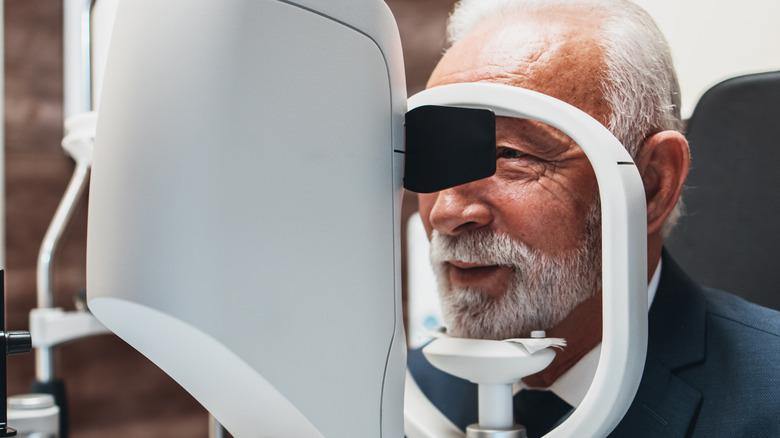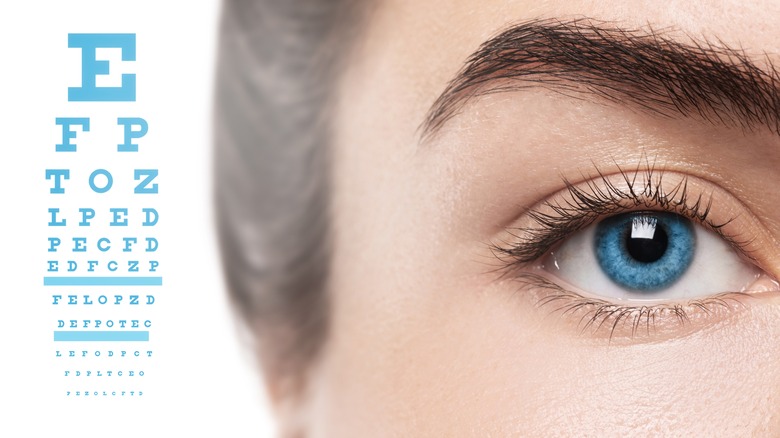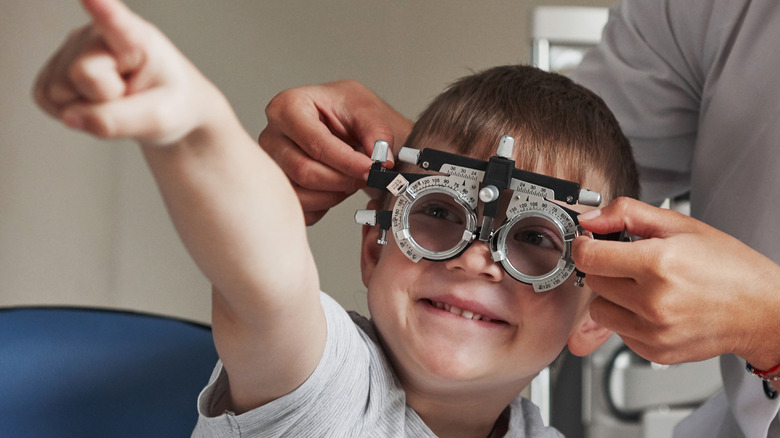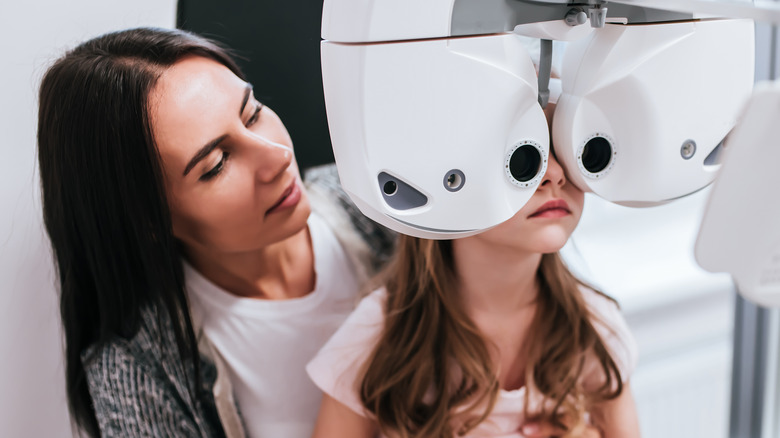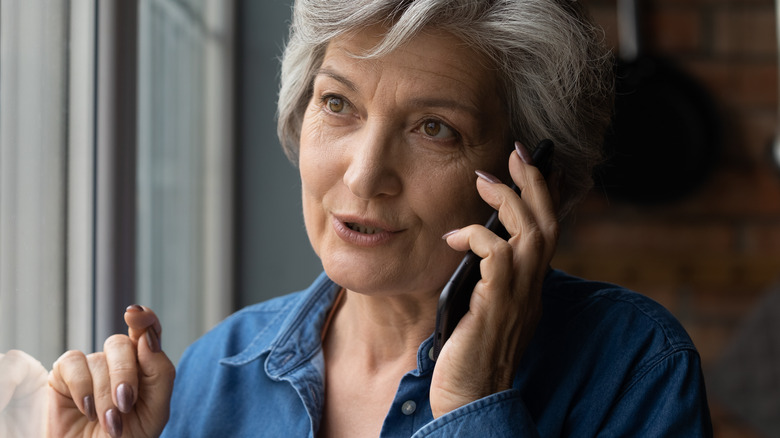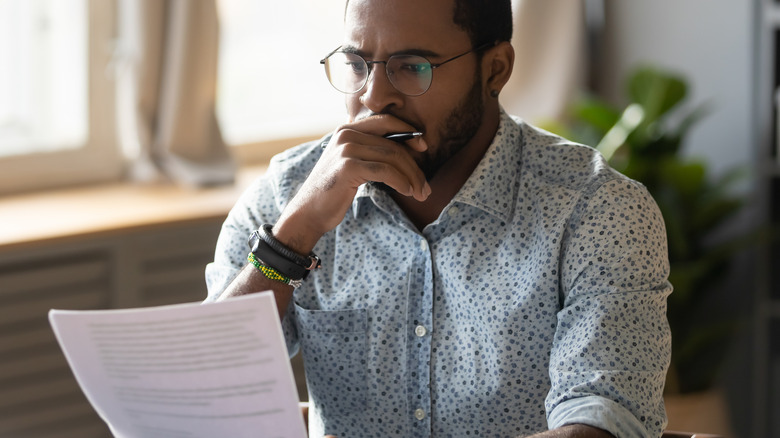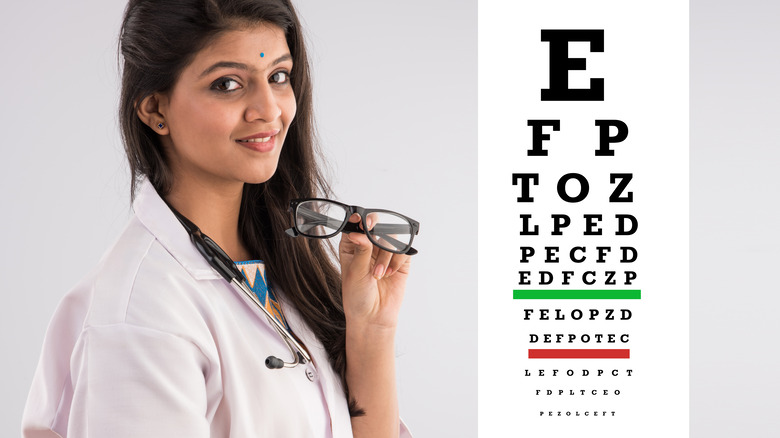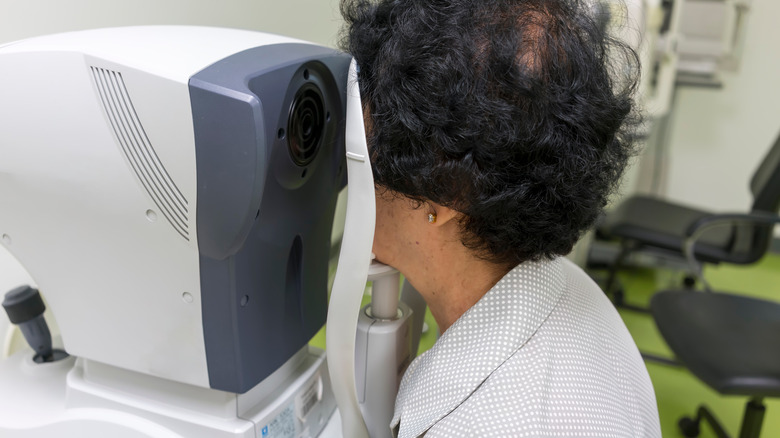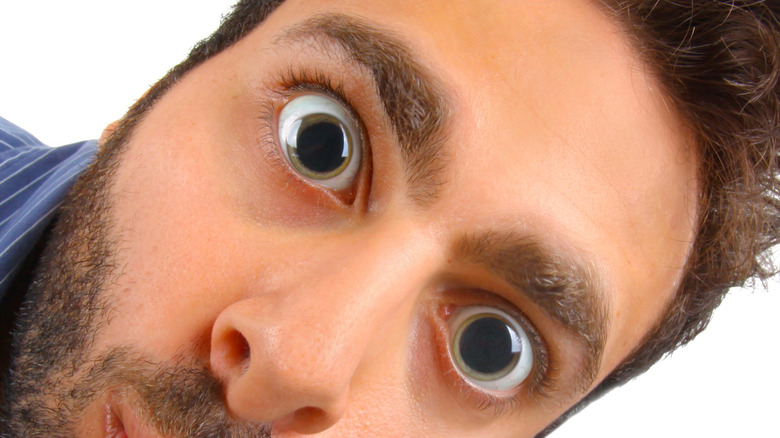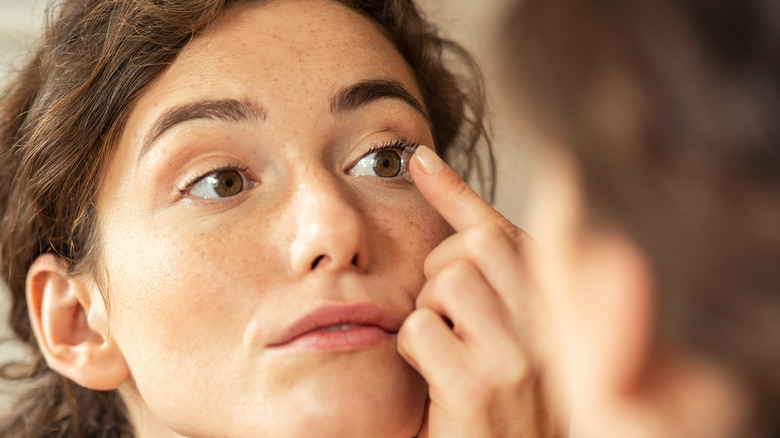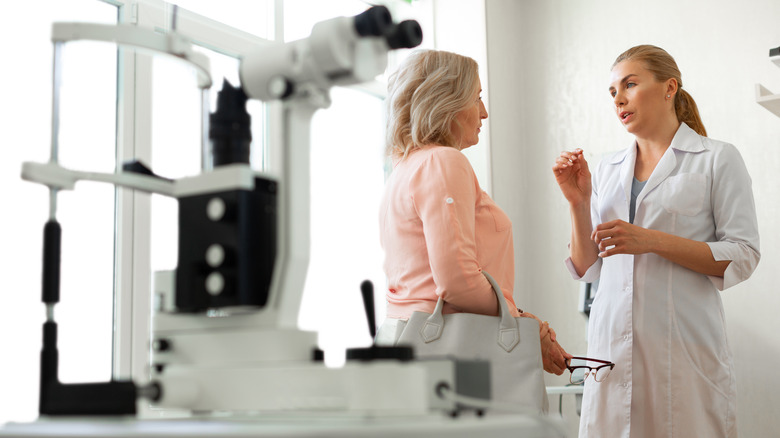Everything You Should Know Before Getting An Eye Exam
You probably think that an eye exam is, well, just an exam that's going to tell you if you need glasses or a new prescription for glasses. But an eye exam can reveal so much more than that — and may be your first indication that you have a serious health issue (via the American Academy of Ophthalmology).
A few of the health problems an eye exam can catch include high blood pressure and heart disease, multiple sclerosis, rheumatoid arthritis, thyroid disease, and stroke. An eye exam can also reveal cancer, diabetes, and brain tumors, just by having an eye doctor checking your eyes!
Of course, eye exams are important for less dramatic reasons as well. For example, you should see an eye doctor if you find yourself squinting and still can't focus the fine print, if it's getting harder to see at night, or if you're getting headaches centered around your eyes and forehead (via All About Vision). Also, if you can't remember when you had your last eye exam, chances are it's time to make an appointment.
This is how often adults need an eye exam
How often you need an eye exam varies depending on your age, says the American Academy of Ophthalmology. Assuming your vision is fine, you don't wear contact lenses, and you don't have diabetes or a family history of eye disease, it's recommended that you get a baseline exam once in your 20s and twice in your 30s. If you wear contacts, an exam every year is recommended. If you have diabetes or high blood pressure, or if your family has a history of eye disease, it's wise to talk to your ophthalmologist about how often you should consult an eye specialist.
You'll need a comprehensive eye exam when you reach 40, the time when eyes often start changing rapidly. At this age, you may develop some chronic diseases that can affect your eyes. And once you're 65 or older, an eye exam every year or two will give your eye specialist a chance to check for age-related eye conditions like cataracts and macular degeneration.
Hopefully, it goes without saying that all of these schedules fly out the window if you injure your eyes or your eyes start acting up (like you suddenly have flashes of light or floaters in your eyes, pain, blurred vision, or sensitivity to light). If you notice any of these symptoms, schedule an appointment with your specialist right away (via Empire Retina Consultants).
Kids need vision checks from birth through childhood
A child's first vision screening should be shortly after birth to check the infant's eye health, including blink and pupil response (via the American Academy of Ophthalmology). An ophthalmologist should do a comprehensive exam if any anomalies are noticed during the screening, or if the baby has a family history of childhood eye disease, signs of eye disease, or was born prematurely. At six to 12 months, a second screening should be done, usually as part of a well-child exam, and then again between 12 and 36 months. If anything worrisome is caught at that visit, the child may be referred to an ophthalmologist.
Vision and eye alignment are usually checked when a child is between three and five, and this exam can be done by a family doctor, pediatrician, optometrist, ophthalmologist, or orthoptist (a healthcare professional who treats problems with eye muscles, such as being cross-eyed or having double vision, says the Cambridge Dictionary).
It's also important for a child's vision to be checked as soon as they are old enough to read and, if problems are detected, to get treatment as soon as possible. After age five, vision screenings are recommended every one to two years (via Kaiser Permanente).
Ways to put your child at ease during an eye exam
Preparing your child for a comfortable, stress-free eye exam can begin well before the visit. For starters, schedule the appointment for a time when your child will be well-rested and well-fed (via Teeple Optometry). In the days leading up to the exam, talk to your child about how amazing eyes and vision are, as well as the exciting machines that will be used to look inside their eyes when they see the eye doctor. Assure your child that nothing will hurt, and leave out negative statements (e.g., "You'd better not cry during the eye test").
On the day of the visit, bring their favorite stuffed toy along with you, and play their favorite music. Stay with them in the exam room, let them hold the stuffed animal during the appointment, and play the music quietly in the background, as advised by the experts at Falcon Vision.
Eye exams shouldn't be scary, and most eye care professionals who work with children know how to engage them and put them at ease. Anything you can do to make sure it's a positive experience is just icing on the cake.
Know the difference between an optometrist, an ophthalmologist, and an optician
Think of an optometrist as your primary care eye doctor (via Medical News Today). They are trained to perform eye tests, prescribe and dispense corrective lenses, detect certain eye conditions, and prescribe some medications. Optometrists have received a doctor of optometry (OD) degree after completing two to four years of college, followed by four years of optometry school, says the Optometrists Network. Many optometrists have also completed years of post-graduate training so they can manage more complex eye conditions, as well as complete eye exams for special needs children.
An ophthalmologist is a medical doctor who diagnoses and treats all eye diseases and conditions, and also performs eye-related surgeries. These doctors have earned a four-year college degree and completed at least eight years of additional medical training to become a medical doctor (MD) or a doctor of osteopathic medicine (DO). Some ophthalmologists have also completed what's known as a fellowship — additional years of training to specialize in areas such as pediatrics, glaucoma, and laser refractive surgery.
Once you've seen an optometrist or ophthalmologist to get an eye exam and a prescription for corrective lenses, your next stop may be at the optician's office to choose and get fitted for eyeglasses and frames (via the American Association for Pediatric Ophthalmology & Strabismus). Opticians check and fit eyeglass lenses and frames, but don't diagnose or treat eye conditions.
How to select the right eye care provider for you
Your primary care doctor may be able to suggest the type of eye care specialist you need to see — optometrist, ophthalmologist, or optician — and even recommend specific individuals who might be a good fit for you (via the National Eye Institute). Also, ask your family and friends if they have an eye doctor they especially like, and if they have any they definitely don't recommend.
If those approaches aren't helpful and you have health insurance, check your plan's website for eye care specialists near you. You can also do a more general online search on websites offered by the American Optometric Association, the American Academy of Ophthalmology, and the American Society of Retina Specialists. Just enter your ZIP code to find clinicians in your area.
Once you've identified the person you'd like to see, find out what the visit is going to cost. If you have health coverage, call your insurance company and ask what eye care services your plan covers and what your out-of-pocket costs will be. If you don't have insurance, just call the doctor's office to ask about costs.
You'll also want to find out about the clinician's office hours and availability, says Rosin Eyecare. Optometrists may have evening and weekend hours. Ophthalmologists usually don't, but you may want to ask them how quickly you can get an appointment if you need immediate care.
Here is how to prepare for your eye exam
Believe it or not, the same rule that applies to going to a party — never arrive empty-handed — applies to going to an eye appointment, says Eye Site on Wellness. No, you don't have to bring hors d'oeuvres or a dessert. However, there are a number of things you'll want to have in hand to make your appointment go smoothly.
If you wear glasses or contact lenses, bring them to your visit, along with sunglasses, in case your eyes are dilated for the exam. (Eyes are super sensitive to sunlight when they're dilated.) If you wear contact lenses and they were prescribed by another eye specialist, bring that prescription with you, as well as results from CT scans, sonograms, and other tests that were performed elsewhere (via the University of Michigan W.K. Kellogg Eye Center). Being prepared with a list of all the medications you're on, including over-the-counter drugs and supplements, is also important, says Eye Site on Wellness. Your eye care provider may also want contact information for your primary care doctor, so be ready with that at the appointment.
Doctors often send out paperwork for you to fill out before a visit, including new patient questionnaires and HIPAA forms. Complete any forms you were sent and bring them to your appointment, along with a way to pay for the visit.
Know your personal and family health and vision history
The fact that you have diabetes, high blood pressure, or a variety of other health conditions may not seem like something your eye doctor needs to know about, but that information is actually very relevant (via Bromberg Eye Care).
For example, having diabetes puts you at risk of diabetic retinopathy, cataracts, and glaucoma. High blood pressure can harm the blood vessels in and around your eyes. Liver disease can lead to corneal and lens damage if left untreated. And untreated autoimmune conditions can result in eye problems that can even include vision loss.
Your eye specialist also needs a good account of any problems you've been having with your eyesight, says Shopko Optical. Keep a record of symptoms like sensitivity to light, blurred or double vision, headaches, or eye pain. Note when you experience them, how long they last, and if you notice anything that makes the symptoms better or worse. You can also use a symptom log to keep track of symptoms you want to discuss with your eye specialist.
As for your family's vision history, find out if your siblings, parents, or grandparents have had (or currently have) any eye conditions such as cataracts, glaucoma, or macular degeneration, which are hereditary. Your eye doctor will want to evaluate your risks for those.
These are the tests that may be performed during your eye exam
A comprehensive eye exam often takes at least an hour and involves a number of tests to thoroughly evaluate your eye health (via Cigna). The visual acuity test, which tests your vision in each eye, is the one most people are familiar with. It's where you cover one eye at a time and read a chart across the room, with letters and numbers in decreasing sizes. You know, that test where the type gets teeny-tiny and you start saying, "Uh, I think it's an A, but maybe it's an L." The test also reveals how well you can see at a distance.
The ocular motility test involves holding your head still while your eyes follow the movement of a hand-held light or some other object, says All About Vision. This test looks for problems with eye movements, which may affect your ability to read and cause eye strain. You may also have a visual field test, where your peripheral vision is examined; a stereopsis test of your depth perception; and a screening test to check your color vision.
During the refraction eye test, says Cigna, your eye doctor will look into a machine that can switch lens strengths back and forth while you read letters and numbers from a chart. First, one eye is tested, then the other, with the objective of determining which corrective lenses are right for you (and if each eye needs a different prescription).
What happens when you get a glaucoma test during an eye exam
A glaucoma test is quick, painless, and can be done in a couple of ways, says WebMD. In one test that's called a tonometer, you'll first get eye drops that numb your eyes, followed by the doctor lightly touching the surface of each of your eyes to measure its pressure. The tool used to do that is called an applanation tonometer or Tonopen, hence the name of the test.
Another way to perform a glaucoma test is to shoot a small puff of air into each of your eyes. The level of resistance your eyes have to the puff tells the doctor the pressure in each eye. If your eye pressure is too high, it may be an indication that you have glaucoma, although a comprehensive eye exam is needed to diagnose the condition (via Hawaii Vision Associates).
A glaucoma test is an especially important part of an eye exam. That's because glaucoma is often only caught once it's already established, and it can lead to vision loss.
Why you need your eyes dilated during an eye exam
Part of an eye exam involves looking at the interior and exterior eye structures to check for eye diseases and other problems, per the experts at Retina Centers of Alabama. Dilating eye drops enlarge your pupils so your eye doctor can get a clear view into your eyes. The drops temporarily paralyze the muscle that makes the pupil smaller, prevent the pupil from focusing, and stimulate the muscle that makes the iris widen.
Your pupils' normal reaction to a light shining toward them is to get smaller (via Retina Specialists), which is the exact opposite of what your eye doctor needs them to do. The dilating drops prevent that, so your doctor can see and evaluate your entire eyeballs, including the retina, optic nerve, and macula (the part of the eye that processes your central vision), per the Cleveland Clinic.
Dilating drops usually take 15 to 30 minutes to start working, and four to six hours to wear off. During that time, focusing on things up close will probably be difficult, so don't plan on reading a book or working on your computer for a few hours. You should also avoid driving, since daylight glare and blurred vision will make it hard to see and be safe on the road.
Expect these steps at a contact lens fitting
During a contact lens fitting, your eye doctor will measure the curvature of the front surface of your eye, known as the cornea (via Real Eyes Optometry). The curve of your cornea determines the curve needed for your contact lenses. Once the contact lenses are shaped to conform to your corneas, they are placed in your eyes and evaluated: Do they rest on the center of your eyes? How does blinking affect their movement? And how is your distance and close-up vision while you're wearing them?
Wearing contacts that don't fit properly can cause discomfort, reduced vision, and abrasions on your corneas. Contacts that are the wrong size may also slip out of place, or entirely out of your eyes. That's why sharing contacts with a friend is a bad idea. Types of contact lenses you may be able to choose from at your fitting appointment include disposable, extended wear, rigid gas permeable, soft, and hard, says Westminster Vision Associates. There are also contact lenses that last an entire year; these are usually recommended for individuals who have eyes that are more difficult to fit.
Most contact lens fittings can be done as part of a comprehensive eye exam, and fitting only takes about 10 minutes if you've had contact lenses before. It takes longer if you're getting contacts for the first time, or if you need multifocal contacts.
Be ready to ask questions at your eye exam
Feel free to ask your eye doctor questions before, during, and after your eye exam. If it will help you feel more comfortable, you might want to ask what tests will be performed, what instruments will be used, and if you should expect any side effects from the tests (via Takle Eye Group). Once the exam is completed, ask what the doctor learned about your vision. If you don't understand the explanation, ask for clarification.
If you get a diagnosis at the appointment, ask about your treatment options, new symptoms you should watch for, and what you can do to protect your eyes and keep the condition from worsening. Minimizing your eyes' exposure to ultraviolet light is a common protective measure, whether or not you have an eye condition.
Your doctor may also recommend exercises to strengthen your eye muscles, foods that are rich in antioxidants, blue-light glasses if you work on a computer a lot, or sports goggles if the activities you enjoy put your eyes at risk, says For Eyes.

